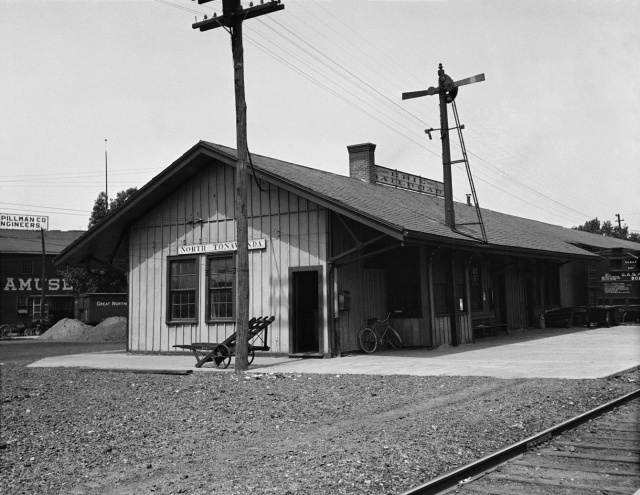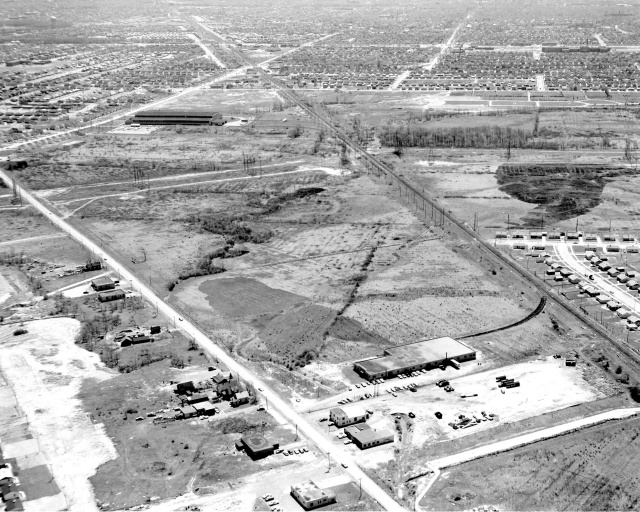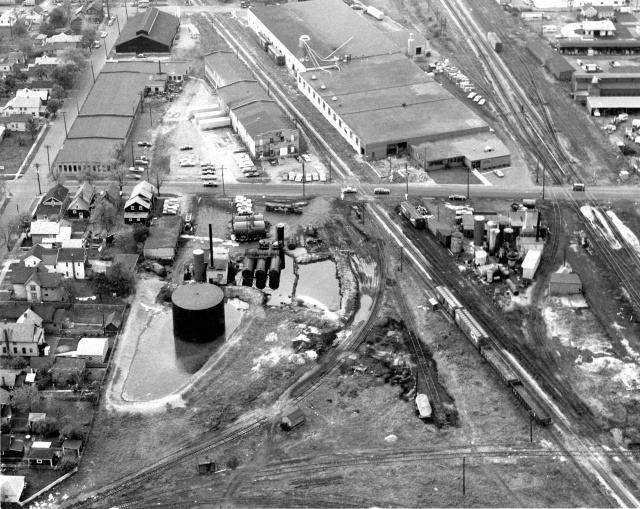TOUR OF THE RAILROAD MUSEUM OF THE NIAGARA FRONTIER
111 Oliver Street • North Tonawanda, NY
Wednesday, September 11, 2019 • 7:00 PM
The Historical Society of the Tonawandas invited its members and guests to a visit to the Railroad Museum of the Niagara Frontier on September 11 at 7 PM. The museum is located at 111 Oliver Street, North Tonawanda, and is located in the 1922 former Erie Railroad freight depot. Note: the building is not handicap accessible, and there are a fewstairs / steps involved for access the building. There is a convenient parking lot in front of the museum and additional parking is available on Oliver Street.
Due to the lack of meeting facilities, there ws no formal program. This was a walk thru visit to tour the building and view exhibits about local Western New York railroading. This year marks 100 years since the construction of the Tonawandas track bypass on the former New York Central Railroad, and a special photo exhibit highlights this project. Members of the Niagara Frontier Chapter will be on hand to help explain exhibits and answer questions.
 In addition, the museum contains exhibits on local streetcar lines and the Niagara Gorge Route. The historic John Roebling Suspension Bridge at Niagara Falls, the Erie Railroad, Lehigh Valley and others which made upthe large number of railway companies which once operated locally are also represented in other photo and artifact exhibits. The museum’s under-preservation EL2 interlocking tower on the west side of Oliver Street will be available for street level inspection, as will the museum’s several pieces of railway equipment, including an Erie caboose, a former Penn Central caboose, and the former Tonawanda Island locomotive. The Chapter library room will also be open for viewing.
In addition, the museum contains exhibits on local streetcar lines and the Niagara Gorge Route. The historic John Roebling Suspension Bridge at Niagara Falls, the Erie Railroad, Lehigh Valley and others which made upthe large number of railway companies which once operated locally are also represented in other photo and artifact exhibits. The museum’s under-preservation EL2 interlocking tower on the west side of Oliver Street will be available for street level inspection, as will the museum’s several pieces of railway equipment, including an Erie caboose, a former Penn Central caboose, and the former Tonawanda Island locomotive. The Chapter library room will also be open for viewing.
Attendees received a complimentary copy of John Dahl’s “Track Relocation in the Tonawandas” that traces the history of the by-pass around downtown Tonawanda and North Tonawanda. The museum gift shop was open with books, pamphlets, and the museum’s new 2020 calendar, gifts for relatives and friends who are railroad enthusiasts.
The original Erie station (shown here) was destroyed by fire in 1920 and the present brick freight house society members will tour was constructed in 1922.
The Society continues the Centennial celebration of the planning, construction, and opening of the New York Central bypass around the City of Tonawanda with a visit and tour of the Railroad Museum of the Niagara Frontier on September 11th. Housed in the former ERIE Railroad freight house, this month’s ROTO features two fascinating aerial views from the Society’s collections of the “other” major railroad that served the Twin Cities for more than a century.

Sometimes, what is not in a photo tells as much of a story as what is. This 1959 aerial view above looking south towards the Town of Tonawanda clearly shows Young Street running at an angle in the lower left, the ERIE Railroad right-of-way on the diagonal to the right, and the Continental Can facility in the upper left of the frame. Brighton Road and Sheridan Drive can be seen beyond the Continental Can facility, as well as the east end of Elmlawn Cemetery to the right. Canton Street dead-ends at the railroad track in the right-center of this photos. What we do not see is the I-290, its Colvin interchange, or any of the familiar structures that developed after its construction, including Twin Fair, BJ’s, Tops Market, The railroad would continue north to its intersection with Young and State Streets before crossing Ellicott Creek and the Canal over its own bridges. This right-of-way has recently been converted to a bike path and walking trail that has its trail-head at the north end of Fillmore Avenue in the City of Tonawanda and the Historical Society is currently working to provide photos for the signage being installed within the city limits.
While photographic images often tell unique stories, aerial photos provide a perspective that can be far more interesting and insightful than what can be viewed from the ground. This early 1970s aerial view of the Robinson Street crossing over the Erie-Lackawanna (former ERIE) and Penn Central (former New York Central) rights-of-way is a compelling snapshot of North Tonawanda industrial history.

Looking south, the above aerial photo clearly shows the rights-of-way of the Erie-Lackawanna (former ERIE) and Penn Central (former New York Central) railroads through North Tonawanda where they crossed Robinson Street on their way from Buffalo to Niagara Falls. It also shows the Central’s yard facility in the upper right and the ERIE’s Lockport Branch in the lower left of the frame. With the exception of the present-day CSX branch line to Niagara Falls and the siding serving the container plant, all of the tracks in this photo no longer exist. While the large Lawless Container Corporation facility in the center of this photo still operates as a corrugated plant under the Westrock name, the large Booth Oil facility on the north side of Robinson Street is gone, the subject of litigation and an expensive cleanup by the Environmental Protection Agency. So are most of the other structures fronting on Robinson Street, a sign of the dramatic changes to the industrial and business landscape that took place in North Tonawanda once the city’s railroad connections were abandoned and torn up.